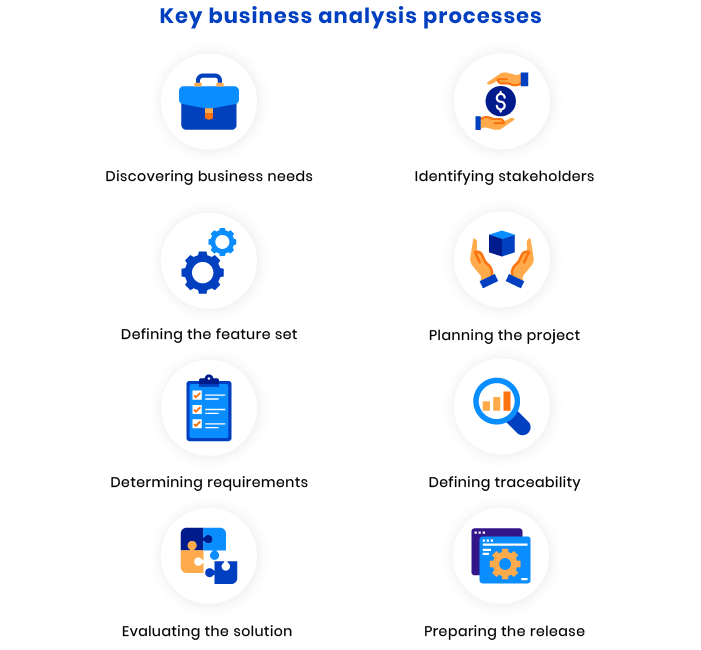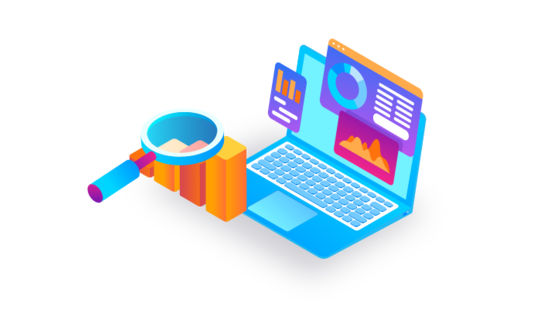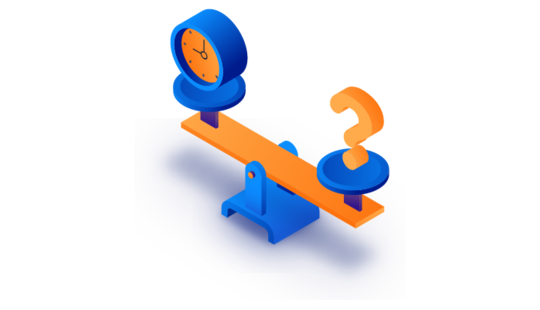-
Product Management
Software Testing
Technology Consulting
-
Multi-Vendor Marketplace
Online StoreCreate an online store with unique design and features at minimal cost using our MarketAge solutionCustom MarketplaceGet a unique, scalable, and cost-effective online marketplace with minimum time to marketTelemedicine SoftwareGet a cost-efficient, HIPAA-compliant telemedicine solution tailored to your facility's requirementsChat AppGet a customizable chat solution to connect users across multiple apps and platformsCustom Booking SystemImprove your business operations and expand to new markets with our appointment booking solutionVideo ConferencingAdjust our video conferencing solution for your business needsFor EnterpriseScale, automate, and improve business processes in your enterprise with our custom software solutionsFor StartupsTurn your startup ideas into viable, value-driven, and commercially successful software solutions -
-
- Case Studies
- Blog
Demystifying the Role of a Business Analyst on Your Project
Why do I need a detailed business analysis? This is one of the questions business owners most frequently ask themselves when developing new products. Our article answers this question and others, such as what business analysis is, when your project needs it, and what is the role of business analyst (BA) in software development. Let’s get started.
What is business analysis?
It’s difficult enough to give a clear definition of what business analysis is since it’s a discipline with broad goals. To understand what business analysis means, let’s consider two concepts that the International Institute of Business Analysis (IIBA) and the Project Management Institute (PMI) offer us.
IBA defines business analysis as the practice of making changes in the operation of an enterprise based on its specific needs and solutions to bring maximum benefit to stakeholders. PMI has a slightly different definition. They define business analysis as the application of knowledge, skills, and techniques aimed at identifying problems and solutions to meet business needs and manage stakeholder requirements to facilitate the successful implementation of the project idea.
These two definitions may sound similar, but the emphases are different. IIBA emphasizes the importance of the role of the BA in driving change in the project, while PMI emphasizes defining requirements for successful project implementation. Nevertheless, both definitions are accurate. At RubyGarage, we believe that business analysis is the practice of identifying and understanding business needs and providing solutions to make changes for their successful implementation.
Who is a business analyst and what role does a BA play in software development?
RubyGarage is convinced that business analysis is an essential part of product development. We strongly recommend that our clients not ignore this process, as doing so can lead to negative consequences that we’ll discuss later.
At RubyGarage, a BA stands between the business and the development team. It’s worth noting that the project manager (PM) is also a buffer between the client and the team, but the tasks of a PM and BA are different. The PM is responsible for ensuring an effective workflow and stable product delivery. The BA’s task is to ensure that the product being delivered meets business objectives.
For BAs to successfully perform their role on a project, they have to do the following:
- Get a clear concept of business objectives. The primary task of a BA is to accurately determine business objectives. Incorrectly defined objectives may result in a product that doesn’t meet stakeholders’ requirements. To avoid this situation, a business analyst conducts interviews and surveys as well as analyzes business documents. These activities are commonly known as requirements elicitation.
- Analyze the business problem. There are many cases when a client’s anticipated solution to a problem is not a solution at all. There are also cases in which the source of the problem lies in a different part of the business process than the one initially considered. Root cause analysis and the five whys often help us understand that a problem isn’t so obvious and that the best solution isn’t the one initially proposed — making developing that solution a waste of effort, time, and money.
- Plan and monitor business analysis activities. Having elicited and analyzed all business needs, a BA documents the business requirements, then plans the business analysis activities and development effort by creating a roadmap. This helps the BA competently plan and monitor all business activities necessary to achieve the ultimate goal — delivering software with great business value.
- Budgeting. Although budgeting isn’t the direct responsibility of business analysts, they’re particularly involved in this process. BAs identify the core feature set necessary for software and, based on specifications, determine how much time and money product delivery may take by asking the development team to estimate the effort required to develop the feature set. This allows the business owner to know what budget is needed before development begins.
- Discover risk factors. Risks are potential problems that can harm the product. For example, when a key specialist leaves a project, it will take some time to find a replacement. This may delay the product release. The task of a BA is to determine all the obvious and hidden risks a project may face and find a way to overcome them or turn them into working solutions. BAs create risk matrices in order to control and monitor possible pitfalls as part of their risk management approach. Although risk management is classically part of project management, BAs see risks like no one else, having an understanding of business goals, requirements, and features.
- Communicate with stakeholders. In order for stakeholders to be aware of how product development is progressing, a BA regularly holds meetings with them. The BA can conduct face-to-face meetings, video calls, or presentations with stakeholders to communicate and prioritize planned activities. Open conversations help BAs and stakeholders reach agreements or discuss options for product development.
- Document requirements. There are several types of requirements: business, stakeholder, system (functional and non-functional), and transition. As their names suggest, these requirements focus on different aspects of the solution delivered to the customer as a response to some business need. For instance, transition requirements focus on the company’s transition from the business process as-is to the business process to-be. Business analysts document requirements with user stories, use case scenarios, graphs, tables, charts, diagrams, and other artifacts so that all stakeholders have a unified understanding of the product’s goals and requirements. This helps prevent misunderstandings between parties. Such situations increase the probability of failure.
- Сommunicate requirements to the development team. If a BA misses a request from stakeholders and doesn’t document it, the development team won’t know about the need to change something. This situation can lead to rework, incurring additional effort and resources. The BA’s task is to document stakeholders’ requirements and ensure that all requests are analyzed and processed.
- Reporting. To keep stakeholders aware of the progress and results of product development, BAs should report regularly. They can present reports in writing, using graphs and charts, or in the form of presentations.
What skill set should a BA have?
Quality business analysis is the result of thorough work. BAs need a special skill set to be able to perform this job efficiently. Here at RubyGarage, we’ve identified a combination of hard and soft skills that we consider to be of particular importance for a business analyst.
Hard skills are things a person can learn through certification programs and by reading books. Soft skills are personality traits that may affect how a person does their job independently and in a team. These are the hard and soft skills we most value in a business analyst at RubyGarage:
- Knowledge of business analysis techniques. To analyze and discover relevant requirements as well as to re-evaluate objectives, a BA has to precisely validate requirements. Doing this requires knowledge of the business model canvas and operating model canvas, different formats for documenting requirements, requirements validation, and prioritization. Using these skills, business analysts can find gaps in the project and create solutions to them.
- Ability to model processes. The job of a business analyst is to build processes that help the client achieve business goals. In order to present these processes to stakeholders and the development team, BAs need to be able to visualize data in the form of tables, charts, or graphs and need to be proficient in notations such as UML and BPMN. Modeling processes makes complex information understandable and digestible for all project participants.
- Critical thinking. Many stakeholders are involved in a project, and each may have their own vision and requests for the product. The BA’s task is to process all requests, understand the reasons for them (the 5 whys technique is extremely efficient for this), analyze each one of these reasons, and prioritize all requests. Critical thinking helps a BA to weed out fundamental and non-essential objectives and create a product that meets business needs.
- Communication. Since business analysts are a bridge between a business and a development team, they must have excellent communication skills to understand and communicate ideas clearly. A BA needs to be able to effectively communicate in person, in writing, and via video conferences. This skill is especially important because communication with stakeholders takes up a large part of the business analyst’s time.
- Adaptability. A BA has to find solutions to stakeholders’ requests. However, market conditions are changing all the time, causing stakeholders to change requests. A business analyst needs to quickly adapt to new situations and constantly search for better solutions.
- Active listening. There are many stakeholders on any project, and it’s the business analyst’s job to listen to them and not miss any important information. For this, BAs need to monitor what each participant is saying as well as their body language. For stakeholders to speak as honestly as possible about their requests, the BA must also eliminate external and internal factors that can affect the conversation. What’s more, a BA should be patient with possible disclosures and not give in to negative emotions.
Key business analysis processes
Now that we know the role of a BA and the skills that business analysts should possess, let’s look at the basic business analysis processes.

Process #1 Discover business needs
A needs assessment is the first step in the business analysis process. This practice helps a BA identify needs or gaps between the current state of the project and the desired end result. To understand the key needs, our business analysts conduct a series of interviews with project initiators. The information obtained from these interviews allows BAs to assess business needs and define the primary goal of the project.
Imagine this situation: A client comes to RubyGarage to begin software development. His company deals in construction materials offline in one state. The company sells these materials to businesses in bulk and works with the same companies over and over, yet they want to expand their presence to more states and broaden their customer network.
The business analyst at RubyGarage would start by conducting a set of interviews, understand how the client’s business processes work right now, and document it in the form of a business model canvas — a chart with elements describing a company’s or product’s value proposition, infrastructure, customers, and finances. Without understanding this, it’s difficult to see the business problem and propose a solution.
Process #2 Identify stakeholders
Once the BA understands the business needs, it’s necessary to identify all stakeholders. A stakeholder is any person, group, or organization that can be affected by a product or can influence the decision-making process or the project’s outcome. Identifying stakeholders will help the BA develop a communication plan and avoid the risk of misunderstandings, evaluate the importance of stakeholders, and determine the influence and impact of individual stakeholders on the development effort.
Writing down the names of key players like business owners, target users, and investors is easy enough. However, there can also be unobvious stakeholders who influence your product. These may include organizations and institutions that monitor a business’s compliance with rules and regulations within a country or industry.
If you’re planning to develop a product for the US market, your business analyst needs to identify the relevant laws in each state and find non-obvious stakeholders like the California Attorney General. The California Attorney General oversees compliance with the California Consumer Privacy Act (CCPA), compliance with which is mandatory for all entities that process the personal data of California users.
In the example of the construction materials company, the list of stakeholders could include the client, the development team, the client’s suppliers/vendors, the client’s buyers/clients, delivery/shipping service partners, etc. All of them would have different interests and inputs into the project. Based on these interests and inputs, the BA would create a stakeholders register, impact map, and RACI matrix to identify stakeholders, understand their impact, and understand the responsibilities and connections between them.
Process #3 Create a feature set
After the BA has identified all stakeholders and requests from them, the process of creating a feature set begins. A feature set shows the amount of work to be done and a list of features for each user group.
Let’s get back to our example with the construction materials company. For this project, the BA would take into account the list of business needs and goals of stakeholders and create a list of user roles that might help each of these groups of stakeholders achieve their goals.
Creating a list of user roles would allow the BA to work out a feature set in the form of a user story map — a list of features that each user role should have in order to use the solution and achieve their goals.
This feature set would be helpful for decomposing the scope of work into units that can be estimated, allowing project initiators to see the whole picture and successfully plan budgets, deadlines, and releases.
Process #4 Plan the project
Creating a project plan means formulating a vision for how to complete the project. This practice helps a BA focus on the main tasks and stay concentrated on the business goal. While a business model canvas reveals insights into the value proposition and ways to alter it to meet new business needs in response to changes, the project plan explains how to create the product.
At this stage, the business analyst creates a roadmap. This document explains the sequence of steps in the product development process and contains information about the time and resources needed to complete each step. The roadmap allows each stakeholder to know where product development is and where it’s headed.
The roadmap can be used by project sponsors or initiators to see the whole picture: what development steps there are, how long they’ll take, and how expensive they’ll be.
Process #5 Determine requirements
After creating a project plan, the business analyst must determine the project requirements. At this stage, the BA decides what activities need to be performed to satisfy our client’s business objectives.
Through individual interviews or group seminars, workshops or questionnaires, and on-site business process observations, a business analyst asks questions of interest and receives information. If the group of stakeholders is large, surveys can be used. These practices let our business analysts draw up a list of requirements.
The business analyst then divides all requirements into six groups:
- Business requirements
- Stakeholder requirements
- Solution requirements
- Functional requirements
- Non-functional requirements
- Transition requirements
This approach helps our BAs highlight the most critical requirements, analyze them, and find solutions to them. Also, BAs document these requirements so they’re clear for all stakeholders — and especially for sponsors. Differing understandings of the feature set and how a solution will work is one of the biggest risks that can undermine development.
Process #6 Defining traceability requirements
A BA needs to decide how to track the fulfillment of requirements to understand when a task is completed and what activities are planned next. For this, our business analysts use a traceability matrix. This is a way of thinking about how requirements are related to each other and how to track them. The matrix is a board where tasks are divided into three categories: to do, in progress, and done.
Tracking and managing requirements ensures that identified requirements are adequately handled and fulfilled. This improves communication within the team, ensures effective management of the overall project scope, and reduces the risk that the project will break the deadline.
Process #7 Evaluating the solution
Requirements and goals may change during the course of a project. One of the tasks of a business analyst is to periodically check the project requirements. By rechecking the project goals, a BA makes sure all requirements correctly reflect the ultimate goal and that solutions developed are relevant to the requirements.
After completing this step, a business analyst sees the whole picture of the project. Rechecking goals allows our BAs to adjust goals and decisions to stay on track with changes in requirements.
Process #8 Preparing the release
The final step business analysis process is the product release. The release occurs gradually, and the task of the business analyst is to plan it according to stakeholders’ requirements.
Planning a release is similar to going up the stairs. Each step gets you closer to your goal. The path is laid at the stage of creating a roadmap. In this way, our BAs assess the entire scope of work and plan the activities to be taken to ensure a successful product release.
An important stage in release planning is creating a transition plan. This approach is suitable for complex or brand-new products. Before releasing a full-fledged product, it should be tested on a trial group of users. Business analysts look at users’ reactions, analyze them, and decide whether a product needs to be changed before its release. In this way, BAs help the development team and the business owner avoid additional expenses for reworking products.
There are many examples of products that were released without the involvement of a business analyst. But at RubyGarage, we prefer to have a BA on every project, as they provide many benefits.
Benefits of business analysis
At RubyGarage, we value every minute and every cent invested in a project. All resources spent need to pay off and bring profit to our clients, which is why we involve professional business analysts in our projects. They allow us to:
- Reduce development costs. Although a business analyst isn’t entirely responsible for a project’s finances, they can influence the cost of a project by clearly defining requirements in order to reduce rework.
- Release products on time. A business analyst creates a roadmap that describes each step and the time it takes to complete certain tasks. This helps us manage our time and guarantees the on-time release of a quality product.
- Solve problems effectively. The primary task of a business analyst is to find solutions to stakeholders’ problems. For this, it’s vital to define requirements and needs. But requirements can change during development. If this happens, a business analyst has to recheck stakeholders’ requirements and objectives and find relevant solutions to them. Without constant rechecking, it’s impossible to develop a product that will meet our clients’ expectations.
Conclusion
Rework, additional expenses, poorly defined goals, and missed deadlines are every entrepreneur’s biggest nightmare. A business analyst is the glue between the business and the development team that can help avoid these problems. We hope this article has shed some light on the importance of business analysts and given you a clear understanding of the value they bring.
FAQ
-
To perform business analysis successfully, a BA needs to do following:
- Get a clear concept of business objectives
- Analyze the business problem
- Plan and monitor business analysis activities
- Budgeting
- Discover risk factors
- Communicate with stakeholders
- Document requirements
- Сommunicate requirements to the development team
- Reporting
-
There are eight main business analysis processes:
- Discovering business needs
- Identifying stakeholders
- Defining the feature set
- Planning the project
- Determining requirements
- Defining traceability
- Evaluating the solution
- Preparing the release
-
There are a lot of benefits a BA can bring to your product. The main ones are:
- Reduced development costs
- On-time product releases
- Effective problem-solving
Want your software to serve your business needs? We’re here to assist.










